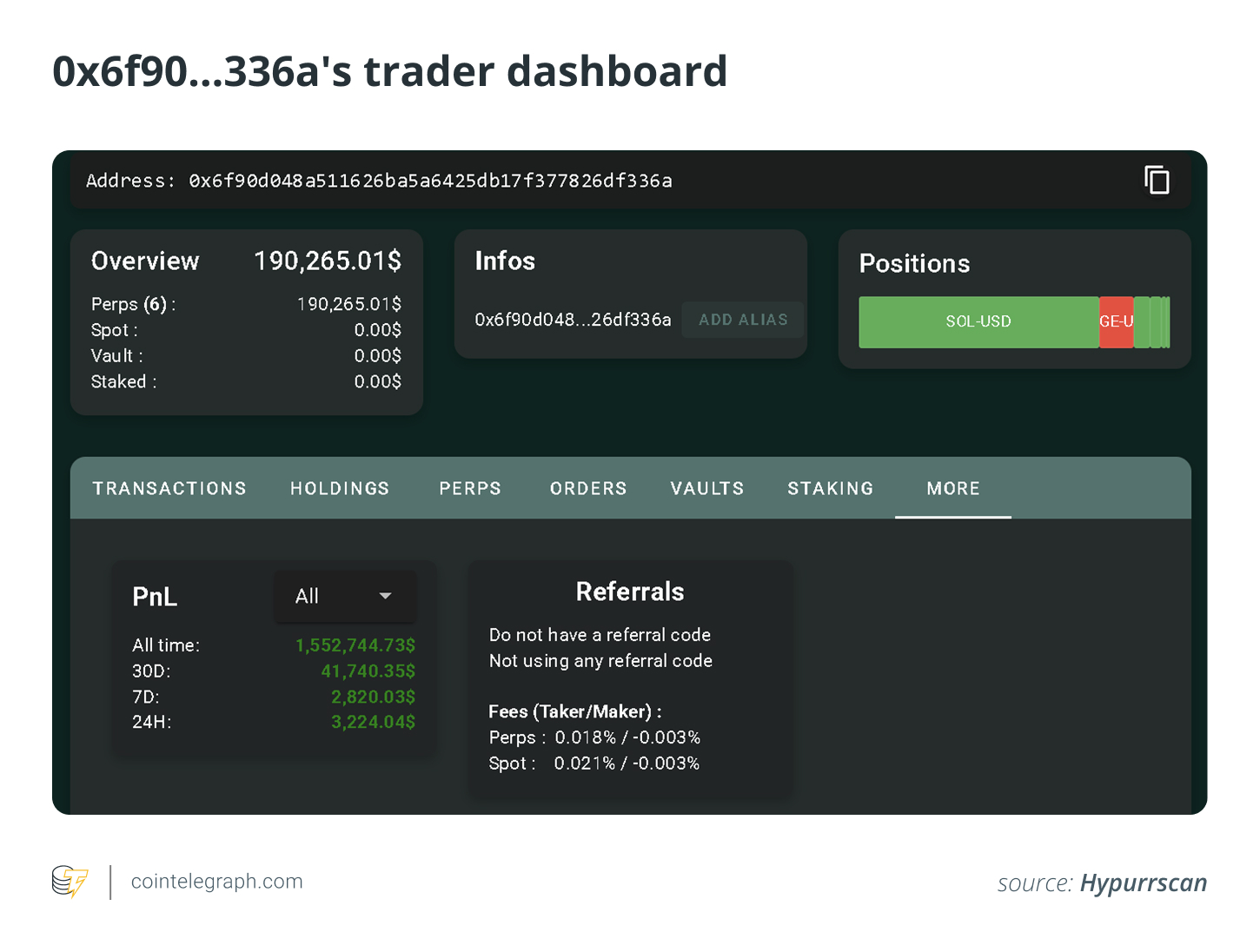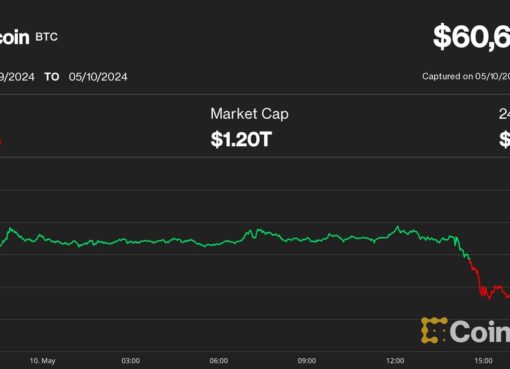Small crypto trader’s success: $6,800 to $1.5 million
In just two weeks, a relatively unknown trader turned a mere $6,800 into $1.5 million without chasing memecoins, betting on price direction or riding ETF hype.
Instead, this small crypto trader cracked a sophisticated crypto market-making strategy: high-frequency, delta-neutral and fueled by maker fee rebates. By quietly becoming a dominant liquidity source on a major perpetual futures platform, they pulled off one of the most efficient, profitable crypto trading tactics of 2025.
This was infrastructure mastery at its best — colocation, automation and razor-thin exposure.
The result was a 220x return powered by a crypto maker liquidity strategy that most retail traders wouldn’t dare attempt.
Did you know? High-frequency traders can generate Sharpe ratios tens of times higher than traditional investors, thanks to their ability to profit from tiny, fleeting inefficiencies.
The platform and the trader behind the $1.5-million run
By mid-2025, the decentralized perpetuals exchange Hyperliquid had quietly become the proving ground for an elite kind of crypto trading.
On-chain sleuths began tracking wallet “0x6f90…336a,” which started trading Solana (SOL) perpetual futures and other assets on the platform back in early 2024 — with just under $200,000 in capital.
Fast-forward to June: The wallet had pushed over $20.6 billion in trading volume, accounting for more than 3% of all maker-side flow on the platform. Interestingly, it was the discipline that triggered this attention, not a whale position or some kind of speculative pump.
The strategy kept net delta exposure under $100,000, avoided blowups and featured consistent withdrawals. The trader was dubbed a “liquidity ghost” on platforms like Hypurrscan.io, with X accounts like Adverse Selectee amplifying the buzz.
Did you know? Despite racking up $1.5 million in profit, the actual amount actively deployed in this perpetual futures crypto trading strategy was just $6,800 — less than 4% of the account’s equity.
The crypto market-making strategy: Profitable crypto trading tactics
At the heart of this high-risk crypto strategy was a powerful trifecta: precision execution, tight exposure limits and a structure designed to earn from volatility, not predict it.
One-sided quoting only
The bot posted only bids or asks, never both, creating directional micro-liquidity. Unlike classical symmetric market-making, this one-sided quoting system reduced inventory risk while making the strategy leaner and more efficient.
Rebate extraction at scale
The core revenue driver was maker rebates, around 0.0030% per fill. That’s just $0.03 per $1,000 traded, but when applied to billions in volume, the earnings scaled dramatically. This tactic only works with automated market-making bots and latency-optimized infrastructure.
Ultra-fast execution layer
Over a two-week stretch, the trader moved roughly $1.4 billion in volume, indicating hundreds of turnover cycles per day. This is only possible with latency-optimized execution: bots running on colocated servers, tightly synced with exchange order books.
Risk limits and delta discipline
Even with billions flowing through the wallet, drawdowns maxed out at just 6.48%. The strategy was a masterclass in crypto trader risk management, never allowing market exposure to spiral out of control.
No spot, staking or guesswork
The system avoided crypto spot vs. futures misalignment by sticking strictly to perpetual futures contracts. This ensured all trading was structurally neutral — leveraging volatility and liquidity mechanics, not price predictions.
Crypto maker liquidity strategy — from maker rebates to $1.5 million
At first glance, this looks like a fluke: $6,800 turned into $1.5 million. But under the surface lies a deeply engineered crypto market-making strategy that capitalized on microstructure inefficiencies, scale and automation.
The math behind it is surprisingly clean: $1.4 billion in volume × 0.0030% maker rebate = ~$420,000. That alone is impressive. Add in compounding, where profits are redeployed in real time, and you get exponential growth.
For comparison, even aggressive yield farming or staking strategies rarely deliver more than 10x returns over a similar window.
It’s worth repeating that this crypto delta-neutral trading approach generated a 220x return, with no price calls, no memecoins and no leverage punts.
Did you know? This kind of success doesn’t come cheap. This system demanded colocated servers, latency-optimized execution and constant real-time calibration.
What makes this high-risk crypto strategy unique?
What sets this strategy apart is the precision, the method and the microstructure edge.
One-sided execution vs. traditional MM
While most market makers post both bids and asks, this trader posted just one at a time, flipping between the two with algorithmic precision. This reduces inventory risk but opens the door to adverse selection, where smarter players pick off your quotes.
Rebate-driven arbitrage
The strategy harvested rebates from every trade on a decentralized perpetuals exchange. The more perpetual futures volume processed, the more rebates earned. It was a pure crypto maker liquidity strategy, executed at extreme scale.
High-frequency automation
To clock hundreds of cycles per day and hit $1.4 billion in volume in just 14 days, the trader likely deployed automated market-making bots synced to the exchange via the Hypurrscan.io dashboard or similar tooling.
Not easily copied
Retail traders can’t just spin this up. You need speed, capital, precision coding and deep hooks into centralized exchange liquidity systems. It’s the opposite of plug-and-play.
Compared to other strategies
This was about exploiting crypto spot vs. futures inefficiencies, not predicting where SOL or Ether (ETH) was headed. It’s the difference between operating the casino and playing at the table.
Risks and caveats: Crypto trader risk management
This setup may be elegant, but it’s not bulletproof. In fact, its strength — speed and structure — is also its fragility.
Infrastructure risk
Bots crash. Exchanges go down. Colocation gets disrupted. Any glitch in this latency-sensitive system can freeze rebate flow and leave the trader exposed mid-cycle.
Strategy-specific risk
One-sided quoting is inherently exposed to market shifts. When volatility spikes or ETH ETF flows surge unexpectedly, smarter players can reverse-engineer your quote behavior. A maker-rebate arbitrage can flip into a loss spiral.
Limited replicability
Even if you understand the model, running it requires capital, backend access and millisecond response times. That excludes most of the market.
Regulatory and platform risk
High-frequency strategies on DEXs might dodge surveillance for a while, but Know Your Customer (KYC) tightening or updated DEX smart contracts could shift the playing field overnight. Also, don’t forget maximal extractable value (MEV) risks.
The bigger picture: A new era of crypto delta-neutral trading
This story is a signal of where crypto is going.
Liquidity provision has become an active, engineered profession, especially with the rise of perpetual futures and rebate-driven trading mechanics.
What used to be handled by centralized teams is now available to coders, quants and technical traders who know how to deploy automated market-making bots at scale.
Emerging traders should take note, as the real edge in 2025 is in building tools, optimizing latency and managing exposure with discipline.
The market will always reward risk. But, increasingly, it favors those who engineer it well.





